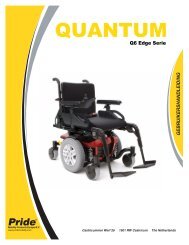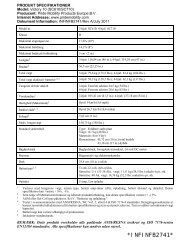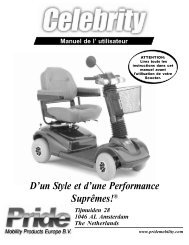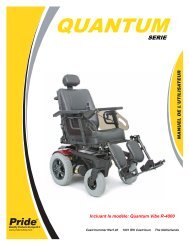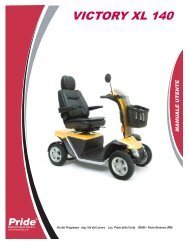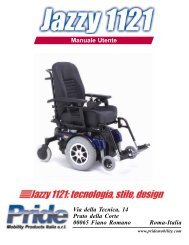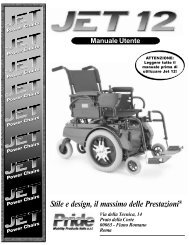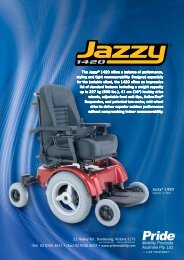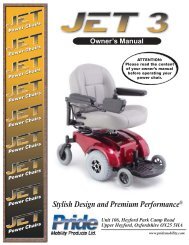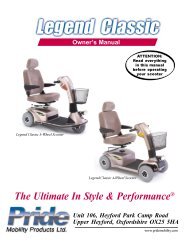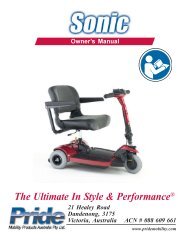Owner's Manual - Pride Mobility Products
Owner's Manual - Pride Mobility Products
Owner's Manual - Pride Mobility Products
Create successful ePaper yourself
Turn your PDF publications into a flip-book with our unique Google optimized e-Paper software.
Owner’s <strong>Manual</strong><br />
ATTENTION:<br />
Please read the content<br />
of your owner’s manual<br />
before operating your<br />
scooter.<br />
The Ultimate In Style & Performance ®<br />
Unit 106, Heyford Park Camp Road<br />
Upper Heyford, Oxfordshire OX25 5HA<br />
www.pridemobility.com
INFMANU1876/REV E/JANUARY 2003<br />
SAFETY GUIDELINES<br />
Please read and follow all instructions in this owner’s manual before attempting to operate your scooter<br />
for the first time. If there is anything in this manual you do not understand, or if you require additional<br />
assistance for setup, contact your authorised <strong>Pride</strong> provider.<br />
Using your <strong>Pride</strong> product safely depends upon your diligence in following the warnings, cautions, and<br />
instructions in this owner’s manual. Using your <strong>Pride</strong> product safely also depends upon your own good<br />
judgement and/or common sense, as well as that of your provider, caregiver, and/or healthcare professional.<br />
<strong>Pride</strong> is not responsible for injuries and/or damage resulting from any person’s failure to follow<br />
the warnings, cautions, and instructions in this owner’s manual. <strong>Pride</strong> is not responsible for injuries and/<br />
or damage resulting from any person’s failure to exercise good judgement and/or common sense.<br />
The symbols below are used throughout this owner’s manual to identify warnings and cautions. It is very<br />
important for you to read and understand them completely.<br />
WARNING! Failure to heed the warnings in this owner’s manual may result in personal injury.<br />
CAUTION! Failure to heed the cautions in this owner’s manual may result in damage to your<br />
scooter.<br />
Copyright © 2003<br />
<strong>Pride</strong> <strong>Mobility</strong> <strong>Products</strong> Ltd.
Sonic<br />
CONTENTS<br />
I. INTRODUCTION......................................................................................................................... 4<br />
II. SAFETY ......................................................................................................................................... 6<br />
III. SPECIFICATIONS ................................................................................................................... 15<br />
IV. YOUR SONIC ............................................................................................................................. 17<br />
V. BATTERIES AND CHARGING ............................................................................................ 20<br />
VI. OPERATION ............................................................................................................................... 25<br />
VII. COMFORT ADJUSTMENTS................................................................................................ 26<br />
VIII. DISASSEMBLY AND ASSEMBLY ..................................................................................... 28<br />
IX. OPTIONAL ACCESSORIES ................................................................................................. 30<br />
X. BASIC TROUBLESHOOTING ............................................................................................. 31<br />
XI. CARE AND MAINTENANCE ................................................................................................ 33<br />
XII. WARRANTY ................................................................................................................................34<br />
3
I. INTRODUCTION<br />
Welcome to <strong>Pride</strong> <strong>Mobility</strong> <strong>Products</strong> Ltd. (<strong>Pride</strong>). Congratulations on the purchase of your new <strong>Pride</strong> Scooter.<br />
Your scooter design combines the most advanced state-of-the-art components with modern, attractive styling. We<br />
are certain that the design features and trouble-free operation will add convenience to your daily living and ensure<br />
complete satisfaction.<br />
At <strong>Pride</strong>, your safety is important to us. Please read and follow all of the instructions in this manual before<br />
you attempt to operate your scooter for the first time. These instructions were produced for your benefit.<br />
Your understanding of these instructions is essential for the safe operation of your new <strong>Pride</strong> Scooter.<br />
<strong>Pride</strong> is not liable for damage to property or personal injury arising out of the unsafe use of a <strong>Pride</strong> Scooter. <strong>Pride</strong><br />
is also not liable for any property damage or personal injury arising out of the failure of any person and/or user to<br />
follow the instructions and recommendations set forth in this manual or any other instructions or recommendations<br />
contained in other scooter related literature issued by <strong>Pride</strong> or contained on the <strong>Pride</strong> Scooter itself.<br />
This owner’s manual is compiled from the latest specifications and product information available at the time of<br />
publication. We reserve the right to make changes as they become necessary. Any changes to our products may<br />
cause slight variations between the illustrations and explanations in this manual and the product you have purchased.<br />
If you experience any problems with your scooter that your are not able to solve, or if you do not feel capable of safely<br />
following any of the instructions and/or recommendations contained in this manual, please contact your authorised<br />
<strong>Pride</strong> provider for assistance.<br />
Once you understand how to operate and take care of your scooter, we are certain that it will give you years of troublefree<br />
service and enjoyment.<br />
Information Exchange<br />
We want to hear your questions, comments, and suggestions regarding this manual. We would also like to hear about the<br />
safety and reliability of your new <strong>Pride</strong> Scooter, and the service you received from your authorised <strong>Pride</strong> provider.<br />
Please notify us of any change of address so we can keep you apprised of important information regarding safety, new<br />
products, and new options that can increase your ability to use and enjoy your <strong>Pride</strong> Scooter. Please feel free to write us<br />
at the address below:<br />
<strong>Pride</strong> <strong>Mobility</strong> <strong>Products</strong> Ltd.<br />
Unit 106, Heyford Park Camp Road<br />
Upper Heyford, Oxfordshire OX25 5HA<br />
4 Sonic
My Authorised <strong>Pride</strong> Provider Is:<br />
Sonic<br />
I. INTRODUCTION<br />
Name:_______________________________________________________________________________<br />
Address:_____________________________________________________________________________<br />
Phone Number:________________________________________________________________________<br />
Quick Reference Information:<br />
Scooter Model:________________________________________________________________________<br />
Serial Number:__________________________________________________________________________<br />
Purchase Date:________________________________________________________________________<br />
NOTE:If you ever lose or misplace your warranty card or this owner’s manual, write or e-mail us and we<br />
will be glad to send you a new one immediately.<br />
5
GENERAL<br />
II. SAFETY<br />
WARNING! Do not operate your new scooter for the first time without completely reading and<br />
understanding this owner’s manual.<br />
Your Sonic is a state-of-the-art life-enhancement device designed to increase mobility. <strong>Pride</strong> provides an extensive<br />
variety of products to best fit the individual needs of the scooter user. Please be aware that the final selection and<br />
purchasing decision regarding the type of scooter to be used is the responsibility of the scooter user who is capable<br />
of making such a decision and his/her healthcare professional (i.e., medical doctor, physical therapist, etc.).<br />
The contents of this manual are based on the expectation that a mobility device expert has properly fitted the<br />
scooter to the user and has assisted the prescribing healthcare professional and/or the authorised <strong>Pride</strong> provider in<br />
the instruction process for the use of the product.<br />
There are certain situations, including some medical conditions, where the scooter user will need to practice<br />
operating the scooter in the presence of a trained attendant. A trained attendant can be defined as a family member<br />
or care professional specially trained in assisting a scooter user in various daily living activities.<br />
As you begin using your scooter during daily activities, you will probably encounter situations in which you will<br />
need some practice. Simply take your time and you will soon be in full and confident control as you maneuver<br />
through doorways, on and off elevators, up and down ramps, and over moderate terrain.<br />
MODIFICATIONS<br />
<strong>Pride</strong> has designed and engineered your Sonic to provide maximum mobility and utility. A wide range of accessories<br />
is available from your authorised <strong>Pride</strong> provider to further customize your scooter to better suit your needs<br />
and/or preferences. However, under no circumstances should you modify, add, remove, or disable any feature,<br />
part, or function of your scooter.<br />
WARNING! Do not modify your scooter in any way not authorised by <strong>Pride</strong>. Unauthorised modifications<br />
may result in personal injury and/or damage to your Sonic.<br />
REMOVABLE PARTS<br />
WARNING! Do not attempt to lift or move a scooter by any of its removable parts. Personal injury<br />
and damage to the scooter may result.<br />
6 Sonic
Sonic<br />
II. SAFETY<br />
PRE-RIDE SAFETY CHECK<br />
Get to know the feel of your scooter and its capabilities. <strong>Pride</strong> recommends that you perform a safety check before<br />
each use to make sure your scooter operates smoothly and safely. For details on how to perform these necessary<br />
inspections, see XI. “Care and Maintenance.”<br />
Perform the following inspections prior to using your scooter:<br />
n Check all electrical connections. Make sure they are tight and not corroded.<br />
n Check the brakes.<br />
n Check battery charge.<br />
If you discover a problem, contact your authorised <strong>Pride</strong> provider for assistance.<br />
WEIGHT LIMITATIONS<br />
Your Sonic is rated for a 113 kg, 18 stone (250-lb.) maximum weight limit.<br />
WARNING! Exceeding the weight limit voids your warranty and may result in personal injury and<br />
damage to your scooter. <strong>Pride</strong> will not be held responsible for injuries and/or property damage<br />
resulting from failure to observe weight limitations.<br />
WARNING! Do not carry passengers on your Sonic. Carrying passengers may result in personal<br />
injury and/or property damage.<br />
INCLINE INFORMATION<br />
More and more buildings have ramps with specified degrees of inclination designed for easy and safe access.<br />
Some ramps may have turning switchbacks (180-degree turns) that require you to have good cornering skills on<br />
your scooter.<br />
n Proceed with extreme caution as you approach the downgrade of a ramp or other incline.<br />
n Take wide swings with your scooter’s front wheel around any tight corners. If you do that, the scooter’s rear<br />
wheels will follow a wide arc, not cut the corner short, and not bump into or get hung up on any railing corners.<br />
n When driving down a ramp, keep the scooter’s speed adjustment set to the slowest speed setting to ensure a<br />
safely controlled descent. See IV. “Your Sonic.”<br />
n Avoid sudden stops and starts.<br />
7
II. SAFETY<br />
When climbing an incline, try to keep your scooter moving. If you must stop, start up again slowly, and then<br />
accelerate cautiously. When driving down an incline, do so by setting the speed adjustment dial to the slowest<br />
setting and driving in the forward direction only. If your scooter starts to move down the incline faster than you<br />
anticipated or desired, allow it to come to a complete stop by releasing the throttle control lever. Then push the<br />
throttle control lever forward slightly to ensure a safely controlled descent.<br />
WARNING! When climbing an incline, do not zigzag or drive at an angle up the face of the incline.<br />
Drive your scooter straight up the incline. This greatly reduces the possibility of a tip or a fall.<br />
Always exercise extreme caution when negotiating an incline.<br />
WARNING! You should not travel up or down a potentially hazardous incline (i.e., areas covered<br />
with snow, ice, cut grass, or wet leaves).<br />
WARNING! When on any sort of an incline or decline, never place the scooter in freewheel mode<br />
while seated on it or standing next to it.<br />
Other inclines may be natural or, if man-made, not designed specifically for scooters. Figures 1 and 1A illustrate<br />
your scooter’s stability and its ability to climb grades under various weight loads and under controlled testing<br />
conditions.<br />
These tests were conducted with the Sonic’s seat in the highest position and adjusted rearward on the seat base to<br />
its farthest rearward position. Use this information as a guideline. Your scooter’s ability to travel up inclines is<br />
affected by your weight, your scooter’s speed, your angle of approach to the incline, and your scooter setup.<br />
68 kg 91 kg 113 kg<br />
11 stone 14 stone 18 stone<br />
(150 lbs.)<br />
15.8%<br />
(200 lbs.)<br />
15.8%<br />
(250 lbs.)<br />
14.1%<br />
FIGURE 1. MAXIMUM RECOMMENDED INCLINE ANGLE FOR THE SONIC<br />
68 kg 91 kg 113 kg<br />
11 stone 14 stone 18 stone<br />
(150 lbs.)<br />
12.3%<br />
(200 lbs.) (250 lbs.)<br />
10.5% 10.5%<br />
FIGURE 1A. MAXIMUM RECOMMENDED INCLINE ANGLE FOR THE SONIC WITH REAR BASKET OR OXYGEN TANK<br />
WARNING! Any attempt to climb or descend slopes steeper than those shown in figures 1 and 1A<br />
may put your scooter in an unstable position and cause it to tip, resulting in personal injury.<br />
WARNING! Never use an oxygen tank weighing more than 6 kg (13 lbs.). Never fill the rear basket<br />
with contents exceeding 7 kg (15 lbs.).<br />
8 Sonic
Sonic<br />
II. SAFETY<br />
When you approach an incline, it is best to lean forward. See figures 2 and 2A. This shifts the centre of gravity of<br />
you and your scooter toward the front of the scooter for improved stability.<br />
WARNING! Do not exceed the incline guidelines or any other specifications presented in this<br />
manual.<br />
FIGURE 2. NORMAL DRIVING POSITION<br />
FIGURE 2A. INCREASED STABILITY DRIVING POSITION<br />
CORNERING INFORMATION<br />
Excessively high cornering speeds can create the possibility of tipping. Factors which affect the possibility of<br />
tipping include, but are not limited to, cornering speed, steering angle (how sharply you are turning), uneven road<br />
surfaces, inclined road surfaces, riding from an area of low traction to an area of high traction (such as passing from<br />
a grassy area to a paved area – especially at high speed while turning), and abrupt directional changes. High<br />
cornering speeds are not recommended. If you feel that you may tip over in a corner, reduce your speed and<br />
steering angle (i.e., lessen the sharpness of the turn) to prevent your scooter from tipping.<br />
WARNING! When cornering sharply, reduce your speed. When using your scooter at higher speeds,<br />
do not corner sharply. This greatly reduces the possibility of a tip or fall. To avoid personal injury or<br />
property damage, always exercise common sense when cornering.<br />
BRAKING INFORMATION<br />
Your scooter is equipped with two powerful brake systems:<br />
1. Regenerative: Uses electricity to rapidly slow the vehicle when the throttle control lever returns to the centre/<br />
stop position; and<br />
2. Disc Park Brake: Activates mechanically after regenerative braking slows the vehicle to near stop, or when<br />
power is removed from the system for any reason.<br />
9
II. SAFETY<br />
OUTDOOR DRIVING SURFACES<br />
Your scooter is designed to provide optimum stability under normal driving conditions—dry, level surfaces composed<br />
of concrete, blacktop, or asphalt. However, <strong>Pride</strong> recognizes that there will be times when you will encounter<br />
other surface types. For this reason, your scooter is designed to perform admirably on packed soil, grass, and<br />
gravel. Feel free to use your scooter safely on lawns and in park areas.<br />
n Reduce your scooter’s speed when driving on uneven terrain and/or soft surfaces.<br />
n Avoid tall grass that can become tangled in the running gear.<br />
n Avoid loosely packed gravel and sand.<br />
n If you feel unsure about a driving surface, avoid that surface.<br />
STATIONARY OBSTACLES (STEPS, KERBS, ETC.)<br />
Always approach a kerb straight on whether ascending or descending it. See figures 3 and 3A.<br />
WARNING! Do not drive near raised surfaces, unprotected ledges, and/or drop-offs (kerbs, porches,<br />
stairs, etc.).<br />
WARNING! Do not attempt to have your scooter climb or descend an obstacle that is inordinately<br />
high. Serious personal injury and/or damage may result.<br />
WARNING! Do not attempt to have your scooter proceed rearward down any step, kerb, or other<br />
obstacle. This may cause the scooter to tip and cause personal injury.<br />
WARNING! Be sure your scooter is traveling perpendicular to any kerb you may be required to<br />
ascend or descend. See figures 3 and 3A.<br />
WARNING! Do not attempt to negotiate a kerb that has a height greater than 5 cm (2 inches).<br />
KERB<br />
FIGURE 3. CORRECT KERB APPROACH FIGURE 3A. INCORRECT KERB APPROACH<br />
10 Sonic<br />
KERB
STREETS AND ROADWAYS<br />
Sonic<br />
II. SAFETY<br />
WARNING! You should not operate your scooter on public streets and roadways. Be aware that it<br />
may be difficult for traffic to see you when you are seated on your scooter. Obey all local pedestrian<br />
traffic rules. Wait until your path is clear of traffic, and then proceed with extreme caution.<br />
INCLEMENT WEATHER PRECAUTIONS<br />
WARNING! <strong>Pride</strong> recommends that you do not operate your scooter in icy or slippery conditions or<br />
on salted surfaces (i.e., walks or roads). Such use may result in an accident, personal injury, or<br />
adversely affect the performance and safety of your scooter.<br />
WARNING! <strong>Pride</strong> recommends that you do not expose your scooter to any type of moisture at any<br />
time (rain, snow, mist, or wash). Such exposure can damage your scooter. Never operate your<br />
scooter if it has been exposed to moisture until it has dried thoroughly.<br />
FREEWHEEL MODE<br />
Your scooter is equipped with a manual freewheel lever that when pushed rearward allows the scooter to be pushed.<br />
For more information about how to place your scooter into and out of freewheel mode, see IV. “Your Sonic.”<br />
WARNING! Do not use your scooter in freewheel mode without an attendant present. Personal<br />
injury may result.<br />
WARNING! Do not attempt to personally place your scooter in freewheel mode while seated on it.<br />
Personal injury may result.<br />
WARNING! Do not place your scooter in freewheel mode while on an incline. The scooter could roll<br />
uncontrollably on its own, causing personal injury.<br />
An added feature built into the scooter is “push-too-fast” protection which safeguards the scooter against gaining<br />
excessive speed while in freewheel mode.<br />
“Push-too-fast” operates differently depending on which of two conditions exists:<br />
n If the key is removed from the key switch when the scooter is in freewheel mode, the scooter’s controller<br />
activates regenerative braking when the scooter is pushed faster than a maximum threshold which has been<br />
preprogrammed. In this case, the controller is acting as a speed governor.<br />
n If the key is inserted into the key switch while the scooter is in freewheel mode, you will encounter considerable<br />
resistance at any speed. This prevents the scooter from gaining unwanted momentum should the manual<br />
freewheel lever inadvertently be released while driving the scooter.<br />
11
II. SAFETY<br />
STAIRS AND ESCALATORS<br />
Scooters are not designed to travel up or down stairs or escalators. Always use an elevator.<br />
WARNING! Do not use your scooter to negotiate steps or escalators. You may cause injury to<br />
yourself and to others and damage your scooter.<br />
DOORS<br />
n Determine if the door opens toward or away from you.<br />
n Use your hand to turn the knob or push the handle or push-bar.<br />
n Drive your scooter gently and slowly forward to push the door open. Or drive your scooter gently and slowly<br />
rearward to pull the door open.<br />
ELEVATORS<br />
Modern elevators have a door edge safety mechanism that, when pushed, reopens the elevator door(s).<br />
n If you are in the doorway of an elevator when the door(s) begin to close, push on the rubber door edge or<br />
allow the rubber door edge to contact the scooter and the door will reopen.<br />
n Use care that pocketbooks, packages, or scooter accessories do not become caught in elevator doors.<br />
LIFT/ELEVATION PRODUCTS<br />
If you will be traveling with your scooter, you may find it necessary to use a lift/elevation product to aid in transportation.<br />
<strong>Pride</strong> recommends that you closely review the instructions, specifications, and safety information set forth<br />
by the manufacturer of the lift/elevation product before using that product.<br />
BATTERIES<br />
In addition to following the warnings below, be sure to comply with all other battery handling information. For<br />
more information about your scooter’s batteries, see V. “ Batteries and Charging.”<br />
WARNING! Battery posts, terminals, and related accessories contain lead and lead compounds.<br />
Wash hands after handling.<br />
WARNING! Always protect the batteries from freezing and never charge a frozen battery. Charging<br />
a frozen battery may result in personal injury and/or damage to the battery.<br />
PREVENTING UNINTENDED MOVEMENT<br />
WARNING! If you anticipate being seated in a stationary position for an extended period of time,<br />
turn off the power. This will prevent unexpected motion from inadvertent throttle control lever<br />
contact. Failure to do so may result in personal injury.<br />
12 Sonic
Sonic<br />
II. SAFETY<br />
MOTOR VEHICLE TRANSPORT<br />
Currently, there are no standards approved for tie-down systems in a moving vehicle of any type to transport a<br />
person while seated in a scooter.<br />
Although your scooter may be equipped with a positioning belt, this belt is not designed to provide proper restraint<br />
during motor vehicle transport. Anyone traveling in a motor vehicle should be properly secured in the motor<br />
vehicle seat with safety belts fastened securely.<br />
WARNING! Do not sit on your scooter while it is in a moving vehicle. Personal injury and/or property<br />
damage may result.<br />
WARNING! Always be sure your scooter is properly secured when being transported. Failure to do<br />
so may result in personal injury and/or damage to your scooter.<br />
GETTING ONTO AND OFF OF YOUR SCOOTER<br />
Getting onto and off of your scooter requires a good sense of balance. Please observe the following safety tips<br />
when getting onto and off of your scooter:<br />
n Power down your scooter. See VI. “Operation.”<br />
n Ensure that your scooter is not in freewheel mode. See IV. “Your Sonic.”<br />
n Make certain that the seat is locked into place and the key is removed from the key switch.<br />
n The seat armrests can be flipped up to make getting on and off of the scooter easier.<br />
WARNING! Position yourself as far back as possible in the scooter seat to prevent the scooter from<br />
tipping and causing injury.<br />
WARNING! Avoid using your armrests for weight bearing purposes. Such use may cause the<br />
scooter to tip and cause personal injury.<br />
WARNING! Avoid putting all of your weight on the floorboard. Such use may cause the scooter to tip<br />
and cause personal injury.<br />
POSITIONING BELTS<br />
Your authorised <strong>Pride</strong> provider, therapist(s), and other healthcare professionals are responsible for determining<br />
your requirement for a positioning belt in order to operate your scooter safely.<br />
WARNING! If you require a positioning belt to safely operate your scooter, make sure it is fastened<br />
securely. Serious personal injury may result if you fall from the scooter.<br />
13
II. SAFETY<br />
REACHING AND BENDING<br />
Avoid reaching or bending while driving your scooter. When reaching, bending, or leaning while seated on your<br />
scooter, it is important to maintain a stable centre of gravity and keep the scooter from tipping. <strong>Pride</strong> recommends<br />
that the scooter user determine his/her personal limitations and practice bending and reaching in the presence of a<br />
qualified healthcare professional.<br />
WARNING! Do not bend, lean, or reach for objects if you have to pick them up from the floor by<br />
reaching down between your knees. Movements such as these may change your centre of gravity<br />
and the weight distribution of the scooter and cause your scooter to tip, possibly resulting in<br />
personal injury. Keep your hands away from the tyres when driving.<br />
PRESCRIPTION DRUGS/PHYSICAL LIMITATIONS<br />
The scooter user must exercise care and common sense when operating his/her scooter. This includes awareness of<br />
safety issues when taking prescribed or over-the-counter drugs or when the user has specific physical limitations.<br />
WARNING! Consult your physician if you are taking prescribed or over-the-counter medication or if<br />
you have certain physical limitations. Some medications and limitations may impair your ability to<br />
operate your scooter in a safe manner.<br />
ALCOHOL<br />
The scooter user must exercise care and common sense when operating his/her scooter. This includes awareness<br />
of safety issues while under the influence of alcohol.<br />
WARNING! Do not operate your scooter while you are under the influence of alcohol, as this may<br />
impair your ability to drive safely.<br />
14 Sonic
FIGURE 4. SONIC SCOOTER DIMENSIONS<br />
FIGURE 4A. SONIC TYRE DIMENSIONS<br />
Sonic<br />
III. SPECIFICATIONS<br />
19 cm (7.5")<br />
30.5 - 33 cm<br />
(12" - 13")<br />
4.5 cm (1.75")<br />
43 cm<br />
(17")<br />
41 cm (16")<br />
56 - 74 cm<br />
(22"- 29")<br />
53 cm<br />
(21")<br />
30.5 (12")<br />
79 - 81 cm<br />
(31" - 32")<br />
94 cm (37")<br />
86 cm (34")<br />
Turning Radius<br />
7 cm (2.5") REAR TIRE<br />
5 cm (2") FRONT TIRE<br />
15
III . SPECIFICATIONS<br />
Model Numbers SCUK50<br />
Colours Red, Blue, Yellow<br />
Overall Length 94 cm (37 in.)<br />
Overall Width 53 cm (21 in.)<br />
Total Weight Without Batteries 42 kg (93 lbs.)<br />
Heaviest Piece When Disassembled 16 kg (35 lbs.)<br />
Turning Radius 86 cm (34 in.)<br />
Speed (max) Variable up to 6.38 km/h (4.25 mph)<br />
Range Per Charge* (12V 12 AH batteries) Up to 16 km (10 miles)<br />
Ground Clearance 4.5 cm (1.75 in.)<br />
Weight Capacity 113 kg, 18 stone (250 lbs.)<br />
Standard Seating Type: Foldable molded plastic<br />
Dimensions: 43 cm (17 in.) width x 41 cm (16 in.) depth (usable) x 30.5 (12 in.)<br />
height (usable)<br />
Material: Charcoal fabric<br />
Drive System Rear-wheel drive, 24V sealed transaxle<br />
Dual Braking System Electronic, regenerative, and electromechanical<br />
Tyres Type: solid; front: 5 cm x 19 cm (2 in. x 7.5 in.), rear: 7 cm x 19 cm (2.5 in. x 7.5 in.)<br />
Battery Requirements Type: 12 volt<br />
Amp Hours: 12 AH, SLA (sealed lead-acid)<br />
Battery Charger 2-amp charger<br />
Warranty 2-year limited<br />
Accessories Single cane/crutch holder; double cane/crutch holder; walker holder; forearm crutch<br />
holder; oxygen tank holder; rear basket; front basket; cup holder; safety flag; dust<br />
cover; wishbone crutch holder;<br />
* Varies with user weight, terrain type, battery charge, battery condition, and tyre condition.<br />
16 Sonic
TILLER CONSOLE<br />
The tiller console houses all controls needed to drive your scooter, including the speed adjustment dial, throttle control<br />
levers, battery condition metre, status LED, and horn buttons. See figure 5.<br />
Sonic<br />
WARNING! Do not expose the tiller console to moisture. In the event that the tiller console does<br />
become exposed to moisture, do not attempt to operate your scooter until the tiller console has<br />
dried thoroughly.<br />
BATTERY CONDITION METRE<br />
HORN BUTTON<br />
STATUS LED<br />
THROTTLE CONTROL LEVER<br />
IV. YOUR SONIC<br />
FIGURE 5. TILLER CONSOLE<br />
Key Switch<br />
n Fully insert the key into the key switch to power up (turn on) your scooter.<br />
n Remove the key from the key switch to power down (turn off) your scooter.<br />
Throttle Control Levers<br />
These levers allow you to control the forward speed and the reverse speed of your scooter up to the maximum<br />
speed you preset with the speed adjustment dial.<br />
n Place your right hand on the right handgrip and your left hand on the left handgrip.<br />
n Use your right thumb to push the right side of the lever to disengage your scooter’s brakes and move forward.<br />
n Release the lever and allow your scooter to come to a complete stop before pushing the other side of the lever<br />
to move in reverse.<br />
n When the throttle is completely released, it automatically returns to the centre “stop” position and engages your<br />
scooters’s brakes.<br />
Horn Button<br />
The key must be fully inserted into the key switch for the horn to be operational.<br />
n This button activates a warning horn.<br />
n Do not hesitate to use the warning horn when doing so may prevent accident or injury.<br />
KEY<br />
(INSERTED INTO KEY SWITCH)<br />
SPEED ADJUSTMENT DIAL<br />
THROTTLE CONTROL LEVER<br />
Status LED<br />
The status LED will alert you to electrical problems that may occur with the scooter. The LED remains constantly<br />
lit while your scooter is on. If the scooter develops an electrical problem, the status LED will flash a code. See X.<br />
“Basic Troubleshooting” for flash codes. If the status LED flashes a code other than a code listed, contact your<br />
authorised <strong>Pride</strong> provider.<br />
17
IV. YOUR SONIC<br />
Speed Adjustment Dial<br />
This dial allows you to preselect and limit your scooter’s top speed.<br />
n The image of the tortoise represents the slowest speed setting.<br />
n The image of the hare represents the fastest speed setting.<br />
BATTERY CHARGING COMPARTMENT<br />
The batteries, charger power lead receptacle, ammetre, and main circuit breaker (reset button) make up the<br />
battery charging compartment. See figure 6.<br />
Batteries (not shown)<br />
The batteries store the electrical energy needed to power the scooter. The scooter is equipped with an easy to<br />
remove battery pack located within the battery compartment. To view the battery pack, remove the battery<br />
compartment lid.<br />
Charger Power Lead Receptacle<br />
The off-board charger power lead plugs into this receptacle when charging the scooter batteries.<br />
Ammetre<br />
During charging, the ammetre indicates the charging rate, or how hard the charger is working to charge the scooter’s<br />
batteries. See V. “Batteries and Charging.”<br />
Main Circuit Breaker<br />
When the voltage in your scooter’s batteries becomes low or your scooter is heavily strained because of excessive<br />
loads or steep inclines, the main circuit breaker may trip to protect the motor and electronics from damage.<br />
n The main circuit breaker reset button pops out when the breaker trips.<br />
n When the breaker trips, the entire electrical system of your scooter shuts down.<br />
n Allow a minute or two for your scooter’s electronics to “rest.”<br />
n Push in the reset button to reset the main circuit breaker.<br />
n If the main circuit breaker trips frequently, you may need to charge your batteries more often. You may also<br />
need to have your authorised <strong>Pride</strong> provider perform a load test on your scooter’s batteries.<br />
MAIN CIRCUIT BREAKER<br />
(RESET BUTTON)<br />
FIGURE 6. BATTERY CHARGING COMPARTMENT<br />
CHARGER POWER<br />
LEAD RECEPTACLE<br />
AMMETRE<br />
18 Sonic
Sonic<br />
IV. YOUR SONIC<br />
REAR SECTION<br />
The manual freewheel lever, anti-tip wheels, and the motor/transaxle assembly are located on the rear section of<br />
your scooter. See figure 7.<br />
WARNING! Before placing<br />
your scooter into or taking it<br />
out of freewheel mode, remove<br />
the key from the key<br />
switch. Never sit on a scooter<br />
when it is in freewheel mode.<br />
Never put a scooter in freewheel<br />
mode on any incline.<br />
MANUAL FREEWHEEL LEVER<br />
FIGURE 7. REAR SECTION<br />
ANTI-TIP WHEELS<br />
MOTOR/TRANSAXLE<br />
ASSEMBLY<br />
<strong>Manual</strong> Freewheel Lever<br />
Whenever you need or want to push your scooter for short distances, you can put it in freewheel mode.<br />
n The manual freewheel lever is located at the top left of the rear section.<br />
n Push rearward on the manual freewheel lever to disable the drive system and the brake system.<br />
n You may now push your scooter.<br />
n Push the manual freewheel lever forward to reengage the drive and the brake systems; this takes your scooter out<br />
of freewheel mode.<br />
WARNING! Never operate the manual freewheel lever while seated on the scooter or when the<br />
scooter is on an incline.<br />
OPERATING THE MANUAL FREEWHEEL LEVER<br />
n Put the scooter in freewheel mode only when on a flat surface and with the key removed.<br />
n Always push the manual freewheel lever rearward to put the scooter into freewheel mode.<br />
n Always push the manual freewheel lever forward to engage the drive mode.<br />
Anti-Tip Wheels<br />
The anti-tip wheels are an integral and important safety feature of your scooter. Do not, under any circumstances,<br />
remove the anti-tip wheels from your scooter.<br />
Motor/Transaxle Assembly<br />
The motor/transaxle assembly is an electromechanical unit that converts electrical energy from your Sonic’s batteries<br />
into the controlled mechanical energy that drives the Sonic’s wheels.<br />
19
V. BATTERIES AND CHARGING<br />
Your scooter is equipped with two sealed, maintenance free 12 AH batteries.<br />
n Charge the batteries prior to using your scooter for the first time.<br />
n Keeping the batteries fully charged will keep your scooter running smoothly.<br />
READING YOUR BATTERY VOLTAGE<br />
The battery condition metre on the tiller console uses a colour code to indicate the approximate strength of your batteries.<br />
See figure 8. Green indicates fully charged batteries, yellow a draining charge, and red indicates that an immediate<br />
recharge is necessary. To check the charge, you must first unplug the charger power lead and power up your scooter.<br />
NOTE: To ensure the highest accuracy, the battery condition meter should be checked while operating<br />
your scooter at full speed on a level surface.<br />
You can also check the charge using the ammetre. The off-board charger power lead must be plugged into a<br />
standard wall outlet in order to obtain a reading. When the amperage reading is at or near zero amps, the battery<br />
charging is complete. See figure 8A.<br />
FIGURE 8. BATTERY CONDITION METRE<br />
FIGURE 8A. AMMETRE INDICATES<br />
BATTERIES ARE FULLY CHARGED<br />
CHARGING YOUR BATTERIES<br />
Follow these easy steps to charge your batteries safely:<br />
1. Position your scooter close to a standard wall outlet.<br />
2. Remove the key from the key switch.<br />
3. Make certain that the manual freewheel lever is in the drive (forward) position.<br />
4. Remove the charger power lead receptacle cover from the charger power lead receptacle then plug the<br />
appropriate end of the off-board charger power lead into the receptacle.<br />
5. Extend the charger power lead and plug it into the wall outlet. It is recommended that you charge your<br />
batteries for 8 to 14 hours.<br />
WARNING! Never use an extension lead to plug in your battery charger. Plug the charger directly<br />
into a properly wired standard wall outlet.<br />
6. When the batteries are fully charged, unplug the off-board charger power lead from the wall outlet and then<br />
from the charger power lead receptacle.<br />
7. Replace the charger power lead receptacle cover.<br />
NOTE: There is a charger inhibit function on your scooter. The scooter will not run and the battery<br />
condition metre will not operate while the batteries are charging.<br />
20 Sonic
Sonic<br />
V. BATTERIES AND CHARGING<br />
REMOVING THE BATTERY PACK TO CHARGE THE BATTERIES<br />
If you prefer to leave your scooter inside a vehicle or in a place where an electrical outlet is not available, you can<br />
remove the battery pack from the scooter and charge the batteries using the off-board charging harness.<br />
n Remove battery pack. See VIII. “Disassembly and Assembly.”<br />
n Place the battery pack near an electrical outlet.<br />
n Connect the off-board charging harness to the battery harnesses that extend from the battery pack. See figure 9.<br />
n Plug the appropriate end of the charger power lead into the mating end of the off-board charging harness.<br />
n Plug the off-board charger power lead into an electrical outlet.<br />
OFF-BOARD CHARGING HARNESS BATTERY HARNESSES<br />
BATTERY PACK<br />
PLUG INTO OFF-BOARD CHARGER<br />
FIGURE 9. OFF-BOARD CHARGER HARNESS CONNECTIONS<br />
BATTERIES AND CHARGING-FREQUENTLY ASKED QUESTIONS (FAQS)<br />
How does the charger work?<br />
When your scooter’s battery voltage is low, the charger works harder, sending more electrical current to the<br />
batteries to bring up their charge. As the voltage approaches full charge, the charger sends less and less electrical<br />
current to the batteries. When the batteries are fully charged, the current sent by the charger is at nearly zero<br />
amperage. Therefore, when the charger is plugged in, it maintains the charge on your scooter’s batteries, but does<br />
not overcharge them. We do not recommend that you charge your scooter’s batteries for more than 24 consecutive<br />
hours.<br />
What if my Sonic’s batteries won’t charge?<br />
n Ensure that both ends of the off-board charger are inserted fully.<br />
How often must I charge the batteries?<br />
Two major factors must be considered when deciding how often to charge your scooter’s batteries:<br />
n All day scooter use on a daily basis.<br />
n Infrequent or sporadic scooter use.<br />
21
V. BATTERIES AND CHARGING<br />
With these considerations in mind, you can determine how often and for how long you should charge your scooter’s<br />
batteries. We designed the onboard charger so that it will not overcharge your scooter’s batteries. However, you<br />
may encounter some problems if you do not charge your batteries often enough and if you do not charge them on<br />
a regular basis. Following the five guidelines below will provide safe and reliable battery operation and charging.<br />
n If you use your scooter daily, charge its batteries as soon as you finish using it for the day. Your scooter will be ready<br />
each morning to give you a full day of service. We recommend that you charge your scooter’s batteries for 8 to 14<br />
hours after daily use.<br />
n If you use your scooter once a week or less, charge its batteries at least once a week for 12 to 14 hours at a time.<br />
n Keep your scooter’s batteries fully charged.<br />
n Avoid deeply discharging your scooter’s batteries.<br />
n Do not charge your scooter’s batteries for more than 24 consecutive hours.<br />
How can I get maximum range or distance per charge?<br />
Rarely will you have ideal driving conditions—smooth, flat, hard driving surfaces with no wind or curves. Often<br />
you will face hills, pavement cracks, uneven and loosely packed surfaces, curves, and wind, all of which affect the<br />
distance or running time per battery charge. Below are a few suggestions for obtaining the maximum range per<br />
battery charge.<br />
n Fully charge your scooter’s batteries prior to use.<br />
n Plan your route to avoid as many hills, cracked, broken, or soft surfaces as possible.<br />
n Limit your baggage weight to essential items.<br />
n Try to maintain an even speed while your scooter is in motion.<br />
n Avoid stop-and-go driving.<br />
What about public transportation?<br />
If you intend to use public transportation with your scooter, you must contact the transportation provider in advance<br />
to determine their specific requirements.<br />
What type and size battery should I use?<br />
Your scooter comes equipped with two deep-cycle batteries that are sealed and maintenance free. Both sealed<br />
lead-acid and gel cell are deep-cycle batteries that are similar in performance. Do not use wet-cell batteries, which<br />
have removable caps.<br />
Type: Deep-cycle (sealed lead-acid or gel cell)<br />
Voltage: 12 volts each<br />
Size: 12 AH<br />
Why do my new batteries seem weak?<br />
Deep-cycle batteries employ a different chemical technology than that used in car batteries, nickel-cadmium batteries<br />
(nicads), or in other common battery types. Deep-cycle batteries are specifically designed to provide power, drain<br />
down their charge, and then accept a relatively quick recharge.<br />
22 Sonic
Sonic<br />
V. BATTERIES AND CHARGING<br />
We work closely with our battery manufacturer to provide batteries that best suit your scooter’s specific electrical<br />
demands. Fresh batteries arrive daily at <strong>Pride</strong> and are shipped fully charged to our customers. During shipping, the<br />
batteries may encounter temperature extremes that may influence their initial performance. Heat diminishes the<br />
charge on the battery; cold slows the available power and extends the time needed to recharge the battery.<br />
It may take a few days for the temperature of your scooter’s batteries to stabilize and adjust to their new room or<br />
ambient temperature.<br />
WARNING! If your scooter’s batteries become frozen, do not attempt to charge them. Cold or frozen<br />
batteries should be allowed to warm up for several days prior to recharging.<br />
It takes a few charging cycles (partial drains followed by full recharging) to establish the critical chemical balance<br />
that is essential to a deep-cycle battery’s peak performance and long life.<br />
Follow these steps to properly break-in your scooter’s new batteries for maximum efficiency and service life.<br />
1. Fully recharge any new battery prior to its initial use. This charging cycle brings the battery up to about 88% of<br />
its peak performance level.<br />
2. Operate your new scooter in familiar and safe areas. Drive slowly at first, and do not travel too far from your<br />
home or familiar surroundings until you have become accustomed to your scooter’s controls.<br />
3. Fully recharge the batteries. They should be at over 90% of their peak performance level.<br />
4. Operate your scooter again.<br />
5. Fully recharge the batteries again.<br />
6. After four or five charging cycles, the batteries are able to receive a charge of 100% of their peak performance<br />
level and are able to last for an extended period of time.<br />
How can I ensure maximum battery life?<br />
Fully charged deep-cycle batteries provide reliable performance and extended battery life. Keep your scooter’s<br />
batteries fully charged whenever possible. Batteries that are regularly and deeply discharged, infrequently charged,<br />
or stored without a full charge may be permanently damaged, causing unreliable performance and limited service<br />
life.<br />
How should I store my Sonic and its batteries?<br />
See XI. “Care and Maintenance.”<br />
23
V. BATTERIES AND CHARGING<br />
REPLACING YOUR SONIC’S BATTERIES<br />
WARNING! Battery posts, terminals, and related accessories contain lead and lead compounds.<br />
Wash hands after handling.<br />
Battery Removal<br />
1. Remove the battery compartment lid. See figure 10.<br />
2. Disconnect the battery harnesses. See figure 11.<br />
3. Remove the battery pack from the scooter. See figure 11A.<br />
4. Unzip the battery pack and remove the battery or batteries.<br />
5. Disconnect the red (+) positive and black (-) negative<br />
battery leads from the battery terminals by pulling them gently<br />
from the battery terminals. See figure 11B.<br />
Battery Replacement<br />
1. Reconnect the two (2) battery leads to the battery terminals.<br />
See figure 11B.<br />
n Red lead to (+) positive terminal.<br />
n Black lead to (-) negative terminal.<br />
2. Put the battery or batteries back into the battery pack with<br />
the battery terminals facing up.<br />
3. Zip the battery pack and place it back into the battery compartment.<br />
4. Reconnect the battery harnesses.<br />
5. Replace the battery compartment lid.<br />
FIGURE 10. BATTERY COMPARTMENT LID<br />
BATTERY<br />
HARNESSES<br />
FIGURE 11. BATTERY HARNESS REMOVAL<br />
FIGURE 11A. BATTERY PACK REMOVAL<br />
BATTERY<br />
TERMINAL<br />
BATTERY<br />
LEADS<br />
FIGURE 11B. BATTERY LEADS<br />
24 Sonic
Sonic<br />
VI. OPERATION<br />
BEFORE GETTING ON YOUR SCOOTER<br />
n Have you fully charged the batteries? See V. “Batteries and Charging.”<br />
n Is the manual freewheel lever in the drive (forward) position? Never leave the manual freewheel lever pushed<br />
rearward unless you are manually pushing your scooter.<br />
n Is the front tiller lock in the unlocked position? See VIII. “Disassembly and Assembly.”<br />
GETTING ONTO YOUR SCOOTER<br />
1. Make certain that the key is removed from the key switch.<br />
WARNING! Never attempt to board or exit your scooter without first removing the key from the key<br />
switch. This will prevent the scooter from moving if accidental throttle control lever contact is<br />
made.<br />
2. Stand at the side of your scooter and pull up on the seat lock lever and rotate the seat until it is facing you.<br />
3. Make certain that the seat is locked securely in position.<br />
4. Position yourself comfortably and securely in the seat.<br />
5. Pull up on the seat lock lever and rotate the seat until you are facing forward.<br />
6. Make certain the seat is locked securely in position and your feet are safely on the floorboard.<br />
PRE-RIDE ADJUSTMENTS AND CHECKS<br />
n Are you positioned comfortably in the seat? See “Getting Onto Your Scooter,” above.<br />
n Is the seat at the proper height? See VII. “ Comfort Adjustments.”<br />
n Is the seat locked securely in place? See VII. “Comfort Adjustments.”<br />
n Is the tiller at a comfortable setting and locked securely in place? See VII. “Comfort Adjustments.”<br />
n Is the key fully inserted into the key switch? See IV. “Your Sonic.”<br />
n Does the scooter’s horn work properly?<br />
n Is your proposed path clear of people, pets, and obstacles?<br />
n Have you planned your route to avoid adverse terrain and as many inclines as possible?<br />
OPERATING YOUR SONIC<br />
After planning your route:<br />
n Set the speed adjustment dial to your desired speed.<br />
n Press your thumb against the appropriate throttle control lever.<br />
n The scooter accelerates smoothly to the speed you preselected with the speed adjustment dial.<br />
n Pull on the left handgrip to steer your scooter to the left.<br />
n Pull on the right handgrip to steer your scooter to the right.<br />
n Move the tiller to the centre position to drive straight ahead.<br />
n Release the throttle control lever to decelerate and come to a complete stop.<br />
n The electromechanical disc park brake automatically engages when your scooter comes to a stop.<br />
GETTING OFF OF YOUR SONIC<br />
1. Bring your scooter to a complete stop.<br />
2. Remove the key from the key switch.<br />
3. Pull up on the seat lock lever and rotate the seat until you are facing toward the side of your scooter.<br />
4. Make certain that the seat is locked securely in position.<br />
5. Carefully and safely get out of the seat and stand to the side of your scooter.<br />
6. You can leave the seat facing to the side to facilitate boarding your scooter next time.<br />
25
VII. COMFORT ADJUSTMENTS<br />
WARNING! Remove the key from the key switch before adjusting the tiller or the seat. Never<br />
attempt to adjust the tiller or the seat while the scooter is in motion.<br />
TILLER ANGLE ADJUSTMENT<br />
Your scooter is equipped with an adjustable pivoting tiller.<br />
1. Turn the tiller adjustment knob anticlockwise to loosen the<br />
tiller. See figure 12.<br />
2. Move the tiller to a comfortable position.<br />
3. Turn the tiller adjustment knob clockwise to secure the tiller<br />
in position.<br />
NOTE: In order to lower the tiller to the scooter deck, you<br />
must first remove the seat. See VIII. “Disassembly and<br />
Assembly.”<br />
SEAT ROTATION<br />
The seat lock lever locks the seat in one of four positions.<br />
1. Pull up on the seat lock lever to unlock the seat. See<br />
figure 13.<br />
2. Rotate the seat to the desired position.<br />
3. Release the seat lock lever to lock the seat securely in place.<br />
ARMREST WIDTH ADJUSTMENT<br />
The scooter armrest width can be adjusted inward or outward.<br />
See figure 13.<br />
1. Loosen the armrest adjustment knobs at the back of the seat<br />
frame.<br />
2. Slide the armrests in or out to the desired width.<br />
3. Tighten the armrest adjustment knobs as required.<br />
The armrests can also be lifted upward to aid in mounting and<br />
dismounting your scooter.<br />
TILLER ADJUSTMENT<br />
KNOB<br />
ARMREST<br />
FIGURE 12. TILLER ADJUSTMENT<br />
BOLTS<br />
ARMREST ADJUSTMENT KNOBS<br />
SEAT LOCK LEVER<br />
FIGURE 13. SEAT ADJUSTMENTS<br />
FRONT-TO-BACK SEAT ADJUSTMENT<br />
You can reposition the scooter’s seat forward or rearward to one of three settings, thereby adjusting the distance<br />
between the seat and the tiller. See figure 13.<br />
1. Remove the seat from your scooter. Refer to VIII. “Disassembly and Assembly.”<br />
2. Remove the four bolts that fasten the seat to the seat platform.<br />
3. Align the seat platform with the desired set of holes on the seat.<br />
4. Replace and tighten the four bolts securely.<br />
26 Sonic
Sonic<br />
VII. COMFORT ADJUSTMENTS<br />
SEAT HEIGHT ADJUSTMENT<br />
The seat can be repositioned to one of two different<br />
heights. See figure 14.<br />
1. Remove the seat from your scooter. See VIII.<br />
“Disassembly and Assembly.”<br />
2. Use the attached ring to pull and remove the detent<br />
pin from the lower seat post.<br />
3. Raise or lower the upper seat post to the desired<br />
seat height.<br />
4. While holding the upper seat post at that height,<br />
match up the adjustment holes in the upper and<br />
lower seat post.<br />
5. Fully insert the detent pin.<br />
6. Replace the seat.<br />
NOTE: The supplied nut, bolt, and washers can<br />
be used as an alternate to the ball detent pin for<br />
seat height adjustment and stability.<br />
ADJUSTMENT HOLES<br />
DETENT PIN<br />
LOWER<br />
SEAT POST<br />
UPPER SEAT<br />
POST<br />
FIGURE 14. SEAT HEIGHT ADJUSTMENT<br />
27
VIII. DISASSEMBLY AND ASSEMBLY<br />
DISASSEMBLY<br />
No tools are required to disassemble or assemble your Sonic. Always disassemble or assemble your scooter on<br />
a level, dry surface with sufficient room for you to work. Keep in mind that the disassembled sections of a Sonic<br />
take up more floor space than the assembled Sonic.<br />
You can disassemble the Sonic into four pieces: the seat, weighing<br />
9.5 kg (21 lbs.), the front section, weighing 16 kg (35<br />
lbs.), the rear section weighing 16 kg (35 lbs.), and the battery<br />
pack weighing 8 kg (18 lbs.). See figure 15.<br />
Before disassembling the scooter, remove the key and place the manual freewheel lever in the drive (forward) position.<br />
1. Lock the front wheel by pushing the tiller lock knob in and turning it clockwise 90 degrees. See figure 16.<br />
2. Remove seat by pulling it straight upward.<br />
3. Remove the battery compartment lid and place it out of the way.<br />
4. Unplug the motor harness and both battery harnesses. See figure 17.<br />
LOCKED<br />
POSITION<br />
FIGURE 16. TILLER LOCK<br />
(LOCKED)<br />
REAR SECTION<br />
BATTERY PACK<br />
FIGURE 15. DISASSEMBLED SCOOTER<br />
BATTERY<br />
HARNESSES<br />
MOTOR<br />
HARNESS<br />
FRONT SECTION<br />
WARNING! Lifting weight beyond your physical capability may result in personal injury. Ask for<br />
assistance when necessary before disassembling your scooter.<br />
UNLOCKED<br />
POSITION<br />
FIGURE 16A. TILLER LOCK<br />
(UNLOCKED)<br />
FIGURE 17. WIRING<br />
HARNESSES<br />
WARNING! Before getting onto your scooter always check that the tiller lock is in the unlocked<br />
position. Attempting to ride your scooter with the tiller lock in the locked position can result in<br />
personal injury.<br />
28 Sonic<br />
SEAT
VIII. DISASSEMBLY AND ASSEMBLY<br />
Toggle Latch Release<br />
1. Push in the toggle latch release button while pulling back the toggle latch. See figure 18.<br />
2. Position the toggle latch buckle over the top of the toggle latch. See figure 19.<br />
3. Lower the tiller to the scooter floorboard and fully tighten the tiller adjustment knob.<br />
TOGGLE<br />
LATCH<br />
Sonic<br />
FIGURE 18. TOGGLE LATCH<br />
TOGGLE<br />
LATCH<br />
RELEASE<br />
BUTTON<br />
TOGGLE<br />
LATCH<br />
BUCKLE<br />
Frame Separation<br />
1. Push back on the seat post to pivot the scooter’s rear section<br />
rearwards until the rear section is standing vertically on its rear<br />
bumper. See figure 20.<br />
2. Lift the front section up until the lower pegs are no longer in the<br />
slots. See figure 21.<br />
3. Carefully lift the front section vertically away from the rear section.<br />
ASSEMBLY<br />
1. Position the front and rear sections of your scooter as shown in<br />
figure 22.<br />
2. Use the tiller handle to lift the front section as you align the<br />
lower slots of the front section with the corresponding pegs on<br />
the front of the rear section. See figure 21.<br />
3. Holding the seat post, slowly pivot the rear section forward<br />
until the curved locking brackets are fully connected onto the<br />
top rear pegs. See figure 20.<br />
4. Raise the tiller and fully tighten the tiller adjustment knob.<br />
5. Secure the toggle latch. See figure 18.<br />
n Lower the toggle latch buckle.<br />
n Push back on the toggle latch so it locks into place.<br />
6. Connect the motor harness and both battery harnesses.<br />
7. Replace the battery compartment lid.<br />
8. Replace the seat and rotate it until it locks into place.<br />
9. Unlock the front wheel by turning the tiller lock knob 90<br />
degrees anticlockwise. See figure 16A.<br />
WARNING! After assembling the Sonic make absolutely<br />
certain the tiller lock is in the unlocked position<br />
before attempting to ride your scooter.<br />
FIGURE 19. TOGGLE LATCH<br />
FIGURE 20. FRAME POSITIONING<br />
SLOTS<br />
FIGURE 21. FRAME LOCKUP<br />
TILLER HANDLE<br />
FIGURE 22. FRAME HALVES<br />
PEGS<br />
29
IX. OPTIONAL ACCESSORIES<br />
OPTIONAL ACCESSORIES<br />
For information concerning these optional accessories, contact your authorised <strong>Pride</strong> provider.<br />
SINGLE CANE/CRUTCH HOLDER DOUBLE CANE/CRUTCH HOLDER<br />
OXYGEN TANK HOLDER<br />
WALKER HOLDER FOREARM CRUTCH<br />
HOLDER<br />
REAR BASKET FRONT BASKET<br />
SAFETY FLAG CUP HOLDER<br />
30 Sonic
Any electromechanical device requires occasional troubleshooting. However, most problems that arise can usually<br />
be solved with a bit of thought and common sense. Many of these problems occur because the batteries are not<br />
fully charged or because the batteries are worn down and can no longer hold a charge.<br />
DIAGNOSTIC FLASH CODES<br />
The diagnostic flash codes for your Sonic are designed to help you perform basic troubleshooting quickly and<br />
easily. A diagnostic flash code will flash from the status LED in the event one of the conditions listed below develops.<br />
NOTE: Your scooter will not run unless the flash code condition is resolved and the scooter has been<br />
turned off then turned back on.<br />
Sonic<br />
X. BASIC TROUBLESHOOTING<br />
FLASH CODE CONDITION SOLUTION<br />
Batteries are too low to operate the scooter Charge batteries or unplug the off-board charger<br />
or the charger is operating.<br />
power lead from the electrical outlet.<br />
Controller is hot; the scooter seems to be Shut down your scooter for a minimum of several<br />
losing power.<br />
minutes to allow the controller to cool.<br />
Wigwag fault; your throttle control levers<br />
are not responding.<br />
Call your authorized <strong>Pride</strong> provider for assistance.<br />
������������ The manual freewheel lever is in the<br />
(rearward) freewheel position.<br />
Turn the key to the off position, then push the<br />
manual freewheel lever to the (forward) drive<br />
position, restart your scooter.<br />
�������������� Scooter is operating with the charger<br />
attached.<br />
Unplug the off-board charger lead from the<br />
scooter’s charger power lead receptacle.<br />
������������<br />
��������<br />
������������<br />
What if all the systems on my Sonic seem to be “dead”?<br />
n Make certain that the key is fully inserted into the key switch.<br />
n Check that the batteries are fully charged. See V. “Batteries and Charging.”<br />
n Push in the main circuit breaker’s reset button. See IV. “Your Sonic.”<br />
n Make certain that all wiring harnesses (battery and motor) are firmly connected.<br />
n Be sure the auto shutoff feature hasn’t been activated. See below.<br />
AUTO SHUTOFF FEATURE<br />
The scooter is equipped with an energy saving auto shutoff feature.<br />
n If the scooter key switch is left in the on position and the scooter remains inactive for approximately 20<br />
minutes, the motor controller will automatically shut down. This feature is designed to preserve battery life.<br />
NOTE: Although the motor controller will be shut down by the auto shutoff feature, all activated lights will<br />
remain on. For maximum battery life it is recommended that you turn off your lights or turn the key to the<br />
off position.<br />
To restore power back to the scooter:<br />
n Remove the key from the key switch.<br />
n Insert the key back into the key switch.<br />
Your scooter will now resume normal operation.<br />
31
X. BASIC TROUBLESHOOTING<br />
What if the motor runs but my Sonic does not move?<br />
n Your scooter was probably left in manual freewheel mode.<br />
n When the manual freewheel lever is pushed rearward, the brakes are disengaged and all power to the motor/<br />
transaxle is cut.<br />
n Push the manual freewheel lever forward to restore normal operation to your scooter.<br />
What if the main circuit breaker trips repeatedly? See IV. “Your Sonic.”<br />
n Charge the scooter’s batteries more frequently. See V. “Batteries and Charging.”<br />
n If the problem persists, have both of your scooter’s batteries load tested by your authorised <strong>Pride</strong> provider.<br />
n See V. “Batteries and Charging” or III. “Specifications” for information about your scooter’s battery type.<br />
What if the battery condition metre dips way down and the motor surges or hesitates when I press my<br />
Sonic’s throttle control lever? See V. “Your Sonic.”<br />
n Fully charge your scooter’s batteries. See V. “Batteries and Charging.”<br />
n Have your authorised <strong>Pride</strong> provider load test each battery.<br />
If you experience any problems with your scooter that you are not able to solve, contact your authorised <strong>Pride</strong><br />
provider for information, maintenance, and service.<br />
32 Sonic
Sonic<br />
XI. CARE AND MAINTENANCE<br />
Your Sonic requires a minimal amount of care and maintenance. If you do not feel confident in your ability to<br />
perform the maintenance listed below, you may schedule inspection and maintenance with your authorised <strong>Pride</strong><br />
provider. The following areas require periodic inspection and/or care and maintenance.<br />
TYRE CONDITION AND TREAD WEAR<br />
n Regularly inspect your scooter’s tyres for signs of wear.<br />
n Use a rubber conditioner on your scooter’s tyre sidewalls to help to preserve them.<br />
WARNING! Do not apply rubber conditioner on tyre tread; this may cause the tyres to become<br />
dangerously slippery.<br />
EXTERIOR SURFACES<br />
n Bumpers and trim also benefit from an occasional application of rubber or vinyl conditioner.<br />
WARNING! Do not apply a rubber or vinyl conditioner on a scooter’s vinyl seat or floorboard mats;<br />
they will become dangerously slippery.<br />
n The Sonic shroud is made from durable ABS plastic and coated with an advanced formula urethane paint.<br />
n A light application of car wax will help the shroud retain its high gloss.<br />
WIRING HARNESS<br />
n Regularly check the wiring harness insulation for wear or damage.<br />
n Have your authorised <strong>Pride</strong> provider repair or replace any damaged connector, connection, or insulation that<br />
you find before using your scooter again.<br />
AXLE BEARINGS AND THE MOTOR/TRANSAXLE ASSEMBLY<br />
n These items are all prelubricated, sealed, and require no subsequent lubrication.<br />
CONSOLE, CHARGER, AND ELECTRONICS<br />
n Keep these areas free of moisture.<br />
n If any of these items do become exposed to moisture, let them dry thoroughly before operating your scooter<br />
again.<br />
STORAGE<br />
If you plan on not using your scooter for an extended period of time, it is best to:<br />
n Fully charge its batteries prior to storage.<br />
n Disconnect the batteries.<br />
n Store your scooter in a warm, dry environment.<br />
n Avoid storing your scooter where it will be exposed to temperature extremes.<br />
For prolonged storage, you may wish to place several boards under the frame of your scooter to raise the scooter<br />
off of the ground. This takes the weight off the tyres and reduces the possibility of flat spots developing on the areas<br />
of the tyres contacting the ground.<br />
33
XII. WARRANTY<br />
TWO-YEAR LIMITED WARRANTY<br />
Structural frame components, including: platform, fork, seat post, and frame welds.<br />
Drive train, including: differential, motor, and brake.<br />
ONE-YEAR LIMITED WARRANTY<br />
Your scooter is fully guaranteed for the period confirmed on your sales agreement from the date of delivery against<br />
faults arising due to defects in manufacture or materials. This warranty does not detract from, but is in addition to,<br />
your legal rights.<br />
All electronic parts, including controllers and battery chargers, have a one (1) year warranty. Servicing to the<br />
controller or battery charger must be carried out by <strong>Pride</strong>. Any attempt to open or dismantle these items renders<br />
the guarantee void on that item.<br />
NOT COVERED UNDER WARRANTY<br />
This guarantee does not extend to those items which may need replacement due to normal wear and tear (tyres,<br />
belts, bulbs, upholstery, plastic shrouds, motor brushes, fuses, and batteries), or damage to the product caused by<br />
misuse or accident for which <strong>Pride</strong> or its agent cannot be held responsible. This warranty does not include labor or<br />
service calls.<br />
BATTERIES<br />
Batteries are covered by a twelve (12) month warranty from the original manufacturer.<br />
Gradual deterioration in performance due to being left in a discharged state, left in cold conditions for long periods<br />
of time, or worn out through heavy use is not covered.<br />
SERVICE CHECKS AND WARRANTY SERVICE<br />
Warranty service can be arranged by <strong>Pride</strong>. Please contact <strong>Pride</strong> for information on the current cost affecting<br />
service visits.<br />
34 Sonic





